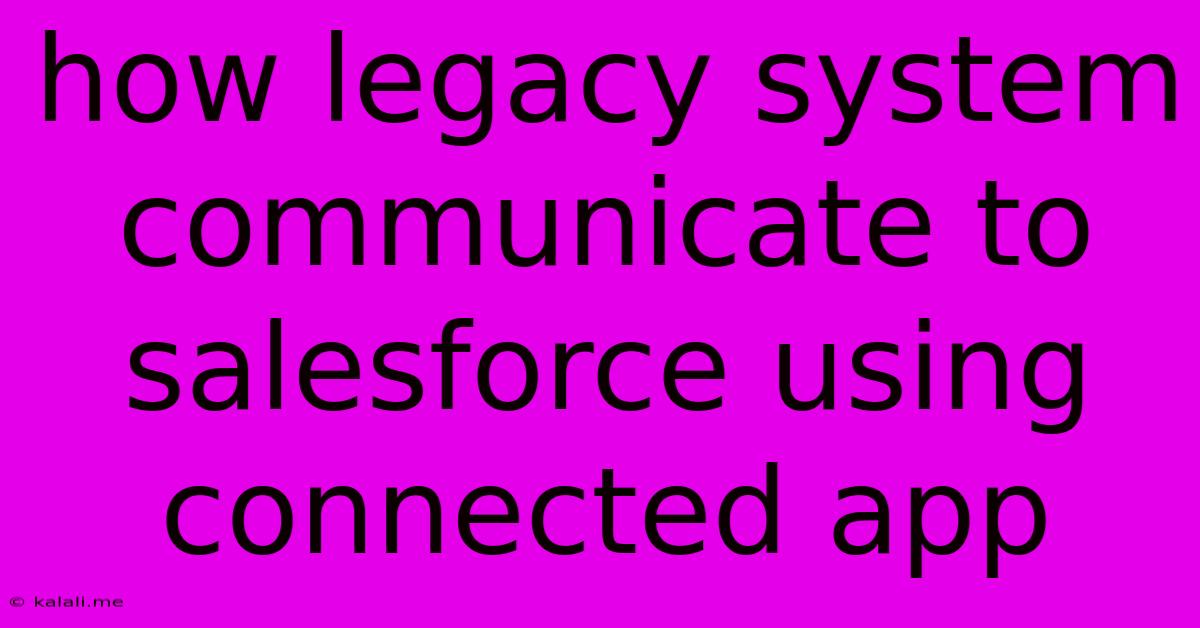How Legacy System Communicate To Salesforce Using Connected App
Kalali
Jun 09, 2025 · 4 min read

Table of Contents
How Legacy Systems Communicate with Salesforce Using Connected Apps
This article explains how legacy systems, often characterized by outdated technologies and architectures, can seamlessly integrate with Salesforce, a leading CRM platform, using Connected Apps. This integration allows for efficient data exchange and automation, bridging the gap between old and new technologies and boosting overall business efficiency. Understanding this process is crucial for organizations seeking to modernize their systems without completely overhauling their existing infrastructure.
Understanding the Challenge: Legacy Systems and Modern CRM
Many businesses rely on legacy systems – older applications and databases that may be incompatible with modern cloud-based solutions like Salesforce. These legacy systems often store crucial business data, making their integration with a modern CRM like Salesforce a critical step towards data unification and improved business processes. Direct integration can be complex and costly, requiring extensive custom coding and maintenance. This is where Connected Apps provide an elegant solution.
The Power of Salesforce Connected Apps
Salesforce Connected Apps offer a secure and standardized way for external applications, including legacy systems, to interact with Salesforce data. They act as a bridge, enabling controlled access to Salesforce features and data without compromising security. This approach reduces the need for complex custom integrations, saving time and resources.
Key Benefits of Using Connected Apps:
- Enhanced Security: Connected Apps provide a secure, controlled environment for data exchange, limiting access only to authorized legacy systems. This minimizes security risks associated with direct integrations.
- Simplified Integration: Connected Apps simplify the integration process, reducing the need for extensive custom code and lowering the overall cost and complexity.
- Improved Efficiency: Automated data synchronization between legacy systems and Salesforce enhances efficiency and reduces manual data entry, minimizing errors and saving time.
- Scalability: Connected Apps can easily scale to handle growing data volumes and changing business needs, making them a future-proof solution.
- Standardized Approach: Using a standardized approach like Connected Apps ensures consistency and simplifies maintenance compared to custom-built solutions.
Connecting Your Legacy System: A Step-by-Step Guide
While the specific implementation details vary depending on your legacy system and its capabilities, the general process involves these key steps:
-
API Selection: Determine the appropriate Salesforce API (REST, SOAP, or Bulk API) to use based on the data volume and requirements. REST API is generally preferred for its flexibility and ease of use.
-
Connected App Creation: Create a Connected App in your Salesforce org. This involves defining the app's name, API access, and OAuth settings to control access permissions and security. This step is crucial in setting up the communication channel.
-
Legacy System Configuration: Configure your legacy system to interact with the Salesforce Connected App. This usually involves setting up authentication and authorization mechanisms using OAuth 2.0 or similar protocols. This requires developers familiar with your legacy system’s programming language and API capabilities.
-
Data Mapping: Define how data will be mapped between your legacy system and Salesforce. This ensures accurate data transfer and consistency. Careful mapping prevents data discrepancies and ensures data integrity.
-
Testing and Deployment: Thoroughly test the integration to ensure data flows correctly and identify any issues before deploying it to production. This is essential to prevent data errors and system disruptions.
-
Monitoring and Maintenance: Continuously monitor the integration to identify any performance bottlenecks or errors. Regular maintenance is crucial for ensuring the long-term success of your integration.
Choosing the Right Approach: API Considerations
The choice of API significantly influences the integration process. Here's a brief comparison:
-
REST API: Generally preferred for its simplicity, flexibility, and suitability for smaller data volumes. It’s often easier to work with for developers familiar with modern web technologies.
-
SOAP API: More complex but suitable for large data volumes and complex transactions. It requires more expertise and may not be the most efficient option for simple integrations.
-
Bulk API: Ideal for high-volume data migrations or batch processing. It's less suitable for real-time data synchronization.
Conclusion
Integrating legacy systems with Salesforce using Connected Apps offers a powerful and efficient way to modernize your business processes. By understanding the key steps and considerations outlined in this article, organizations can seamlessly bridge the gap between their existing infrastructure and the capabilities of a modern CRM platform, leading to improved data management, automation, and overall business efficiency. Remember to prioritize security and thoroughly test your integration before deploying it to a production environment.
Latest Posts
Latest Posts
-
How To Install A Fluorescent Tube Light Bulb
Jun 09, 2025
-
Failed To Create Error Response From
Jun 09, 2025
-
Is It Necessary To Flush Brake Fluid
Jun 09, 2025
-
Another App Is Currently Holding The Yum Lock
Jun 09, 2025
-
How To Clean Mildew Off Concrete
Jun 09, 2025
Related Post
Thank you for visiting our website which covers about How Legacy System Communicate To Salesforce Using Connected App . We hope the information provided has been useful to you. Feel free to contact us if you have any questions or need further assistance. See you next time and don't miss to bookmark.